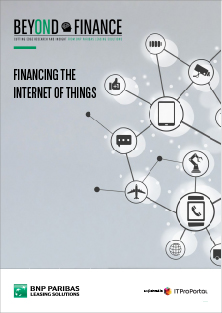By Tristan Watkins, CEO, BNP Paribas Leasing Solutions UK
Expectations for the Internet of Things (IoT) are high, and for good reason. Leading economists believe it will deliver huge productivity gains for businesses, not to mention that its contribution to the global economy over the next decade is estimated to exceed $11 trillion. Companies that equip themselves with best-in-class IoT technology are projected to generate 10% more in profits than those which do not.
Of course, failure to adopt isn’t always a choice: a 2015 Accenture report indicated that two-thirds of companies consider cost a key barrier to IoT uptake. Organisations will always want the latest technology, but the latest technology is expensive – to the point that many SMEs may be effectively frozen out.
The success of the subscription economy offers an alternative way forward, and provides a tried-and-tested model for cost-effective, flexible IoT access. By holding off on outright purchases and financing technology through monthly payments, IT departments can enjoy the benefits of the latest interoperable equipment and software – without breaking the bank.
Setup and implementation
The IoT isn’t, as many still insist, ‘the future’: it’s here already. That said, it’s still relatively new, and even for an experienced IT department, it can be hard to properly implement: for many, sensors, actuators, and M2M communication are a completely different game. There are many potential points of failure: without the necessary help it’s possible to misjudge security challenges, bandwidth requirements, and system integration – rendering the whole deployment an expensive failure.
Subscriptions and leasing solutions will often include install and implementation as well as ongoing support as part of the original arrangement – after all, they don’t want you to stop using the technology. If you don’t know how to facilitate communication between your machines, how to manage bandwidth costs, or where to install sensors, you don’t need to: that’s up to the consultants and support team.
Predictability and flexibility
It’s easy to understand why the IoT claims 24% of IT budgets. M2M deployments have never been cheap, and while sensor prices have trended downwards in recent years, at the medium end of the scale, they can cost around £35-£120, and at the upper end, they can cost up to £750. Purchasing these devices forces you to make hard choices: the level of expense encourages businesses to be extremely judicious about what they can and can’t afford to connect.
By financing an all-inclusive IoT solution, you can get a lot more out of a limited budget –sensors, applications, analytics, network connectivity – whatever you need to create a truly interoperable system. What’s more, there’s always capacity to upscale or downsize in accordance with your business needs: if you’re experiencing a period of growth, you can typically secure the equipment you require without undue hassle; if you need to focus on core functionality and reduce your IT burden, the same principle applies.
With the right funding model, you’ll never use more than you need – and you’ll never have to make do with less.
Future proofing
The IoT may not be ‘the future’ anymore, but there are certainly still improvements to be made. For example, with smart sensors, buyers simultaneously want them to be small enough to be ignorable, powerful enough to perform well for years, and cost-effective. While at present they can mitigate energy consumption to a degree, at best they can only fulfil two of those three criteria. In future, however, it will likely be possible to use longer-living sensors without sacrificing performance or spending a great deal of money: scientists have already made major breakthroughs with nanowires in lithium ion batteries.
There will, no doubt, be other efficiency and productivity gains over the coming years: communication will become faster, interoperability will expand, security will become tighter. When that happens, however, you may find yourself stuck with technology you bought and paid for years ago – and because it functions adequately, you may find it hard to justify the cost of replacing your solution to your finance department.
A major advantage of subscription and leasing models is that, after an agreed term, they can allow you to take advantage of the latest equipment: like a mobile network offering you an upgrade at the end of your contract, the financier will usually offer you new products on existing terms. Staying up-to-date doesn’t have to destroy your budget.
This runs contrary to much conventional wisdom about technology. A simplified version of Varian’s rule is that what the rich have today, others will receive much farther down the line. Subscription and leasing undermine this: they make the best of the IoT available to any business with a simple monthly payment.
Considerable gains in efficiency, connectivity, and profitability are available, and more will be available in the near future – regardless of your company’s size and turnover.
Share post:
Featured in ...

Media contact
Suhale Vorajee
Head of Marketing and Communications
BNP Paribas Leasing Solutions UK
T: 01179 100 895
E: click here





